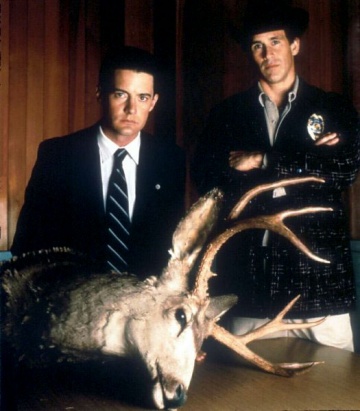by Nicole Boyle and Lauren Smith
Our fan artifact is more of a whole fan infrastructure. The Organization of Transformative Works is an ongoing fan movement that began in 2007 as a response to a corporation’s attempt to set up a profitable online archive– called FanLib– for writers to post their fanfiction. Many fans reacted with outrage: Why should an organization of outsiders try to make a profit out of them? As we’ve discussed in class, fandom has historically resisted the idea of fans making a profit from their fannish writing; partially because of fear of legal prosecution, the tradition of fandom as a gift economy works as a self-policing moral imperative. Fans who attempt to charge for their fanfiction are almost universally condemned by their peers. FanLib’s attempt to profit from its “user-generated content”, therefore, was seen as an ultimate violation: a corporate organization in the realm of passionate amateurs, a board comprised of men in a traditionally female space, disregarding fandom’s pre-existing mores in– for the cherry on the cake– a condescending manner. (A BusinessWeek article notes: “The genius of FanLib is realizing that fans can be happy just being recognized“).
In reaction, a collection of fanfiction writers on LiveJournal (an enormous hub for media fandom on the internet) began to envision an “Archive of One’s Own“. This multifandom repository for fanfic was envisioned as a non-profit endeavor, run for fans by fans. As the fans’ plans coalesced, and a board for the nonprofit organization formed, their ambitions expanded. Under the new name The Organization of Transformative Works (OTW), they also started to plan for a wiki of fannish history and an academic journal about transformative works. Finally, the OTW took the unprecedented step of planning for a system of legal help for fans whose works come under attack for copyright violations. This is significant, because a large contribution to keeping fans and media fandom underground has been the fannish fear of legal action by the holders of copyrighted material.
To show that they were serious about this new organization, the board members attached their real names to the organization. (Note that Rebecca Tushnet, who we will be reading later on in the semester, is on the board). Also, to ensure that OTW never profited or became too controlled by a single fan, the board decided to apply for non-profit organizational status.
******************
The OTW’s incorporation has inspired many ripples of reaction around media fandom. Some fans’ reasons for joining/supporting the OTW (gathered from the OTW’s online newsletter) include:
Naomi Novik describes her reason for dedicating herself: I also care about this community that has welcomed me and given me a place to play and grow. I care about and value the creative work I have done here myself and that’s been made by others that I’ve enjoyed. So I am willing to be serious once in a while too, and to buckle down and do some real and not immediately fun work.
Kristina Busse argues from an acafan’s perspective: Context always matters, but rarely as much as it does in fan fiction, created within and meant for a specific community. If we can create an infrastructure that allows such contextualization of individual stories, we might be a long step toward not everyone trying to find the most ridiculous out there example for a story in order to mock both it and fandom through it.
Dafna Greer cares about the public record:I’m tired of journalists getting everything about fandom wrong. I don’t just mean the simple stuff, like what slash is, or that we’re not all 12 (or 45, or whatever the narrative is that week), I mean the whole context of fandom. You have journalists writing about mash-ups as if vidding never existed and about user-generated content as if it was something invented 2 years ago. It’s just embarrassing. Not as a fan, mind you. It’s embarrassing as a journalist.
Speranza wants autonomy for fans, not free content for outsider corporations: The OTW is created on the model of public television or public radio–Channel 13, as we have it in New York. It’s free. There are no ads. Anyone can watch it or listen to it. And a few people who care about public television and who can afford it become ‘members’–you remember the slogan: ‘this is member-supported NPR, this is member-supported Channel 13.’ And so I’m happy to contribute my time, money, and energy to help fans buy servers and write software and keep our ’social network’ a real community. And I hope you will, too.
******************
Of course, not all fans champion the OTW. The long history of fandom being an underground subculture made some fans wary of change: for example, ethrosdemon relishes the subcultural aspect of media fandom, along a model like Dick Hebdige’s: “Anyway, I didn’t make the choice to bring fandom to the blinding light of day, but in the same breath, I’m not ashamed of it. Yes, we are a subculture obsessed with buttsex, incest, noncon, bestiality, and inside jokes. That’s the appeal, frankly. The SUBcultural aspect is what unites us,” she writes.
Some fans criticized the narrow focus of the OTW:
Purplepopple complains that the OTW will pay too much attention to certain parts of fandom: “Fannish works predate the 1970s. They did not all grow out from the same cultural shared heritage. They were not all tied in to English speaking, Anglo-centric fandom. The concept of fandom predates Star Trek and Harry Potter was not the second biggest most influential fandom after Star Trek.”
Boogieshoes takes issue with OTW’s focus on feminism: “1) i really *don’t* value fandom as a female dominated space – i’d be doing this if there were no girls here tomorrow, and i’d be happy and 2) frankly, *i’d* rather be valued for *what i contribute* than for a genetic quirk i can’t actually control.”
spare_change and Rat Creature points out the problems they have with being represented by acafans: “I don’t think that acafen are the only ones dragging fandom into the public eye. I think that the way they are doing so, however, is just as lame, unrepresentative, and self-serving as FanLib or any ‘look at those wackos’ article on a mainstream news site, though, so I don’t see why I should support them any more than any of the other ways fandom gets publicized.”
For some fans, the OTW’s visibility actives the real fear that fannish activities could hold repercussions for one’s personal life. (In Ethan Zuckerman’s post introducing the OTW, he mentions The Church of Subgenius Custody Case, a similar circumstance in which a woman’s online activities impacted her child custody case).
******************
Finally, sympathetic outsiders to media fandom also reacted to the formation of the new organization:
Ethan Zuckerman, mentioned above, thought it was a good idea: “It’s a fascinating new proto-nonprofit determined to defend media fandom from the excesses of copyright and to help fanfic writers and vidders maintain control of their remixed works.”
BoingBoing’s Cory Doctorow also came out in favor of the organization: “This is such a good idea. When Naomi [Novik] described it at the WorldCon at a panel that we were on together, I wrote her a check on the spot for $500 to fund the org. I hope she cashes it now that they’ve formally announced.”
The Institute for the Future of the Book agreed: “All looks very promising.”
Bob Rehak himself is on the board of the academic journal: “The editors, Kristina Busse and Karen Hellekson, have kindly invited me to participate on the editorial review board; I accepted with pleasure.”
******************
We consider the OTW’s incorporation significant because it represents an unprecedented move in media fandom. We’ve talked in class about capitalistic mainstream forces absorbing fan culture– in the manner Dick Hebdige mentioned mainstream fashion absorbing, and taming, punk style– but the OTW came about because a team of fans refused to let themselves become fodder for a FanLib, capitalist organization. Instead, they organized for their own purposes. The OTW is part of the rising visibility of media fandom, just as is the fact that Swarthmore College is offering this class. Sounds cool? Maybe you should write a paper about it and submit it to the journal!

